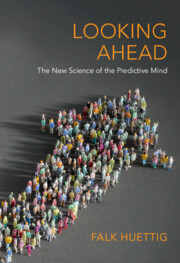Book contents
- Looking Ahead
- Looking Ahead
- Copyright page
- Contents
- Figures
- Preface
- Acknowledgments
- Part I Setting the Stage
- Part II Psychological Theories
- Part III Mathematical Theories
- Part IV Neurobiological Theories
- Chapter 18 Wetware
- Chapter 19 Neuronal Overlap during Observation and Action
- Chapter 20 Forward Models in the Brain
- Chapter 21 Minimization of Prediction Errors by Self-Organizing Biological Systems
- Chapter 22 Information Processing Facilitated by Neural Rhythms
- Part V The Future of Prediction
- Notes
- Index
- References
Chapter 22 - Information Processing Facilitated by Neural Rhythms
Prediction Involves Neural Oscillations
from Part IV - Neurobiological Theories
Published online by Cambridge University Press: 20 March 2025
- Looking Ahead
- Looking Ahead
- Copyright page
- Contents
- Figures
- Preface
- Acknowledgments
- Part I Setting the Stage
- Part II Psychological Theories
- Part III Mathematical Theories
- Part IV Neurobiological Theories
- Chapter 18 Wetware
- Chapter 19 Neuronal Overlap during Observation and Action
- Chapter 20 Forward Models in the Brain
- Chapter 21 Minimization of Prediction Errors by Self-Organizing Biological Systems
- Chapter 22 Information Processing Facilitated by Neural Rhythms
- Part V The Future of Prediction
- Notes
- Index
- References
Summary
Prediction makes use of neural rhythms, oscillating at different frequency bands in the brain, that can be detected and exploited for information processing. Temporal prediction may involve entrainment, that is, alignment to the timing and frequency of external rhythmic stimuli, and oscillatory phase resets that are triggered internally by high-level brain processes.
Keywords
- Type
- Chapter
- Information
- Looking AheadThe New Science of the Predictive Mind, pp. 249 - 262Publisher: Cambridge University PressPrint publication year: 2025

